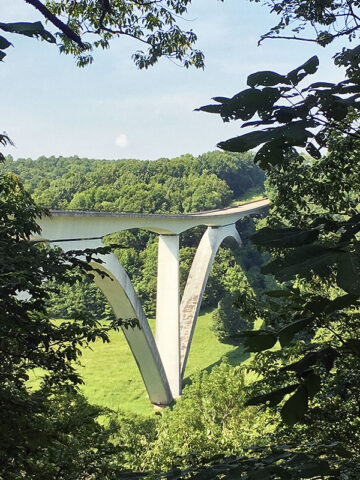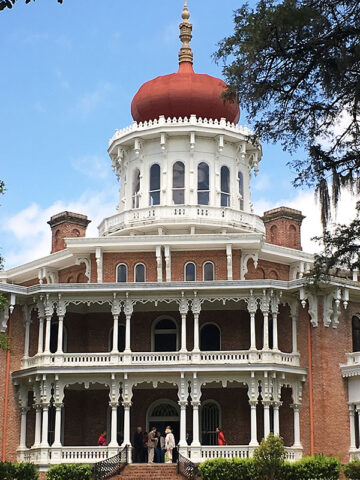Written by Christie Crawford
 Clarksville, TN – A winding ribbon of road through peaceful forests, Southern Appalachian foothills and prairies, and pristine creeks, waterfalls, and bayous-all in our backyard: the Natchez Trace Parkway. This trail is a 444-mile journey through three states, beginning outside Nashville and ending in Natchez, Mississippi, and part of four National Park system parkways.
Clarksville, TN – A winding ribbon of road through peaceful forests, Southern Appalachian foothills and prairies, and pristine creeks, waterfalls, and bayous-all in our backyard: the Natchez Trace Parkway. This trail is a 444-mile journey through three states, beginning outside Nashville and ending in Natchez, Mississippi, and part of four National Park system parkways.
Its beginnings date back to prehistoric times when ancient trails existed for native tribes over thousands of years. It got its name in the late 1700s from farmers and boatmen from the mid-west, often referred to as Kaintucks, who would bring livestock, crops, and manufactured goods from Kentucky, Ohio, and Pennsylvania, traveling down the Mississippi by flatboat to peddle their wares in Natchez and New Orleans.
These traders would sell all, including their boats (not being able to paddle upwards), and walk the distance back along the Natchez Trace. By 1800, this route was the most traveled road in America, and inns formed along the route known as stands to service these weary and scruffy travelers.
As the steamboat era commenced this practice dropped off and the trace became abandoned. It was soon overtaken by wetlands and woodlands. It wasn’t until the turn of the century that a group of DAR (Daughters of the American Revolution) women from Mississippi took up the cause to preserve the Natchez Trace and place monuments and historical markers along its route.
In 1938, the trace became part of the National Trails System, and in 1983, the actual parkway itself became part of the National Park System. Its 75,000 acres now accommodate over 5 million visitors per year. Now the most traveled road in the young United States is again regaining its national significance.
The beauty of this parkway is that it’s easy to venture on and off, depending on whether you want to make a morning or afternoon of it or whether you want to discover the entire stretch. Springtime and fall are exceptional times to view the vibrant colors of wildflowers and trees.
There are historical markers and monuments up and down the entire parkway, and it’s best to do a little reading beforehand on the National Park Service website or app, which points out the highlights with the corresponding milepost numbers. This trace features historic significance, boundless hiking opportunities, and just an overall vista of natural beauty not obscured by traffic or billboards.
I’ll cover some of the highlights by the five sections:
Highland Rim (Tennessee to Alabama)

Make your way to the Nashville entrance just outside Franklin. Have breakfast or lunch at Loveless Cafe, a biscuit destination.
Stop to view the magnificent double arch bridge, a scene of many car commercials.
Pass by lush farms and the artsy town of Leipers Fork to Garrison Creek, an equestrian favorite.
Check out the War of 1812 memorial, where President Andrew Jackson ( then General) marched his troops down the trail to meet their destiny at the Battle of New Orleans and back up again.
Hike over to Jackson Falls, one of two waterfalls in the area adjacent to the Duck River.
View the Gordon House, one of two still-standing structures of stands on the parkway. Captain John Gordon, a local farmer, helped ferry travelers over the Duck River for respite at his home. The home remained until 1859.
Visit Fall Hollow, the only other waterfall on the trace.
Stop at the Meriwether Lewis monument, where tragedy struck the explorer and young governor of the Louisiana territory as he was making his way to lobby in Washington DC. His monument is broken on top, signifying a life cut too short. An excellent visitor center details his story.
Blackland Prairie Section (Mississippi area around Tupelo)

Cross the bridge over the Tennessee River to Colbert Ferry, the only inn on the trace owned by a member of the Choctaw Nation. Although no building remains, trace travelers considered the stand a country estate.
See the burial mound of Bear Creek, which dates back to 8000 BC, where indigenous people, using animal bones, built mounds from dirt to protect sacred remains.
Walk along the ancient trace where 13 unnamed Confederate graves lie.
Divert off the trace to visit Tupelo, best known for being the birthplace of Elvis Presley, and visit his family home.
Also, visit the official visitors center at the Natchez Trace.
Yockanookany Section (Tupelo to Jackson, MS-longest section)
Hike the overlook at Jeff Busby State Park, named for the congressman from Mississippi who in 1934 authorized the survey of the Natchez Trace, paving the way for entry into the national park system.
Sidetrack to French Camp Historic Village, a group of historic buildings dating back to when Louis LeFleur created a stand and trading post with the Choctaw nation.
Take a rest along the banks of the Pearl River named for the French Explorer Pierre Le Moyne, who discovered pearls while sailing into its mouth.
Walk around the eerie but beautiful cypress swamp just north of Jackson.
Rocky Springs Section (Jackson to Rocky Springs)
Take in the old 1700s Rocky Springs ghost town and supposed haunted site of the old town.
Notorious as a popular watering stop for travelers due to its proximity to the springs. An old church and cemetery remain.
Consider a strenuous hike through ravines on the 6-mile trail to Owens Creek waterfall.
Potkopinu Section (Rocky Springs to Natchez)

Make sure to see Mount Locust, one of the oldest structures in Mississippi. Built in 1780, the working cotton plantation and inn was last run by Paulina Ferguson.
Admire the enormity of Emerald Mound, an 8 acre burial mound, the second largest of its era north of Mexico.
Be sure to take time to explore Natchez, an early French settlement which evolved into a major commercial and cultural capital of the old South. Antebellum mansions abound here and were preserved during the Civil War as many owners here were second sons of rich businessmen in the Northeast. The Natchez Garden Club owns a few homes and orchestrates tours of the mansion. Many are available as B & B’s, and are delightful to stay in.
Other things to do from the parkway include visiting Shiloh and Vicksburg Battlefields, and music hotbed Muscle Shoals. For just a few hours or a few days, take time to go back in time and get on the Natchez Trace Parkway.



